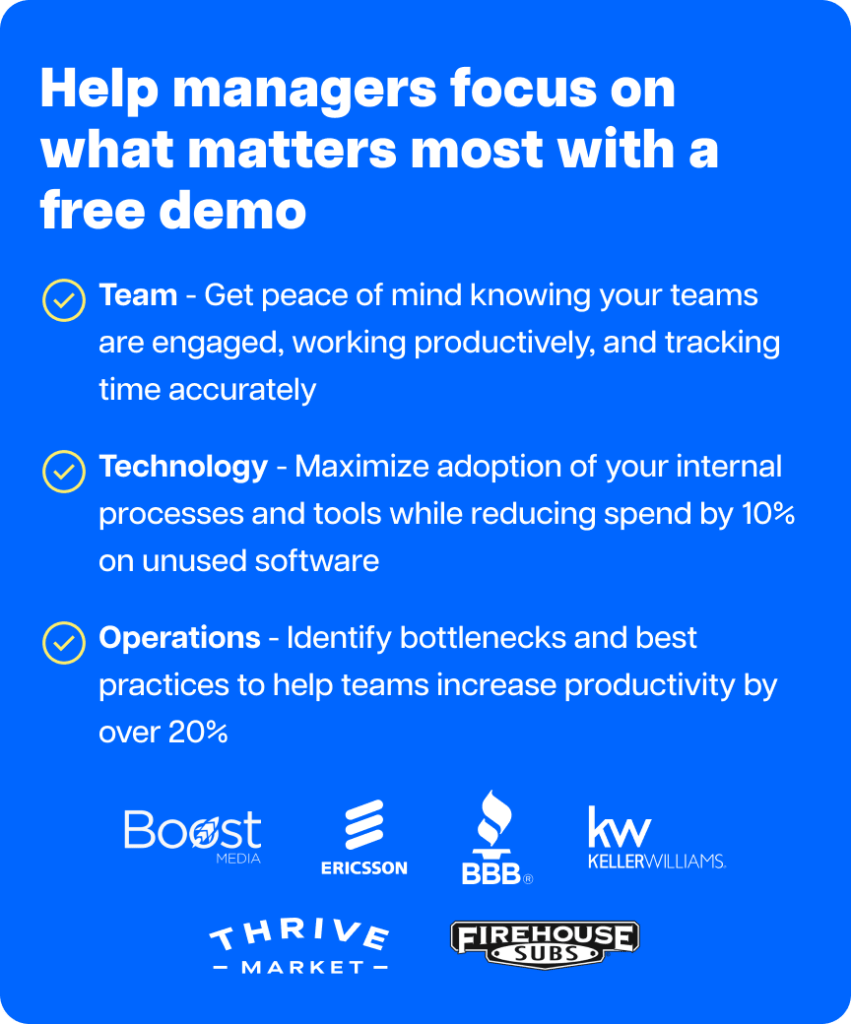A lot is said about the disruptive potential of new technology like AI and remote working tools.
As an organizational leader, this might have you focused on tech investments in 2024.
That’s good. Keeping up with technology ensures your business can deliver what customers expect in terms of speed, service and scale.
But there’s one thing you can’t afford to overlook in digital transformation: the importance of good people.
Effective, future-focused leaders are prioritizing professional development over tech investments.
For one thing, technology needs a skilled human operator. More importantly, there are many human traits that no technology (current or predicted) possesses.
Investing in professional development is not just about filling skills gaps. It’s about building a resilient and adaptable workforce that drives the company forward in a rapidly changing environment.
To help you build a future-ready workforce, we’re answering the question, “What is professional development?” with practical strategies and data-backed insights.
Table of Contents
- What is professional development?
- Why is professional development important for employers?
- The 5 types of professional development
- Crafting and implementing professional development pathways
- Measuring the impact of professional development
- Final thoughts on professional development
What is professional development?
Professional development is the process of acquiring new skills, knowledge and experiences to improve job performance and career potential.
It’s ongoing, goal-oriented, structured and measurable.
Informal professional development opportunities exist, but companies are more likely to recognize formal pathways.
The answer to the question “What is professional development?” is slightly different for managers.
It’s still about building your team’s knowledge, skills and aptitude. However, the added dimension of company performance acts as a filter to ensure development opportunities are mutually beneficial.

Why is professional development important for employers?
Professional development is self-evidently good for employees. But is it good for companies?
Managers might hesitate to provide professional development opportunities because they fear employees will take their new skills to another company.
All the recent data we found suggests the opposite.
Employee retention
94% of employees are more loyal to a company that invests in their development.
LinkedIn
In separate studies, McKinsey and Gallup both found that the #1 reason employees gave for quitting their job during the “Great Resignation” was a lack of career development.
Nobody likes feeling stagnant in their role. And with talent shortages emerging as one of the biggest challenges for companies in the coming years, firms also lose out when good people feel they’re not developing.
Attracting great talent
Nearly 90% of millennials say professional development and career growth opportunities are very important.
Gallup
Companies with strong professional development programs act as a magnet for ambitious people.
After all, an employee who leaves a job that doesn’t fulfill their development needs will be laser-focused on finding a role that does.
You can differentiate your company and attract the brightest talent by showcasing a commitment to continuous learning.
Engagement and motivation
Employees who participated in a structured workplace coaching program were 22% more engaged, and teams led by managers in the program were 18% more engaged.
Gallup
Another Gallup study highlights that employees who know and use their strengths roles are nearly 6x more engaged.
This motivation doesn’t just come from personal achievement. It’s also about feeling integral to the company’s mission and growth.
Professional development programs create a positive feedback cycle in which employees continuously feel valued, fueling their motivation to produce great work.
Keeping up with the competition
Organizations that prioritize employee development report 11% greater profitability and are twice as likely to retain their employees.
Gallup
Professional development plays a crucial role in ensuring that employees – and the company by extension – keep pace with market demands and technological shifts.
This is further reflected in global ‘state of work’ surveys:
- 45% of CEOs think their organizations will no longer be viable in 10 years without reinvention (PwC)
- 60% of organizations face challenges with transformation due to skills gaps in the local labor market (World Economic Forum)
The business landscape is constantly evolving. You need a workforce equipped to adapt and thrive.
The 5 types of professional development
Professional development can take many forms, including formal education, training programs, on-the-job experiences, independent study and industry certifications.
The most effective approach is typically a combination of different methods. We’ll explain this in more detail in Crafting and implementing professional development pathways.
1. Formal education and training
For most people, the question “What is professional development?” conjures the concept of structured learning programs.
These programs are often provided in a classroom setting (physical or virtual) and facilitated by institutions like universities, colleges or registered training providers.
- Degree programs like bachelor’s, master’s or even doctorate degrees equip individuals with in-depth knowledge and skills in their chosen field.
- Certificate programs provide concentrated learning on specific skills or topics relevant to an employee’s career path.
- Corporate training programs through registered trainers can develop employee skillsets aligned with business needs.
Formal education offers a structured learning environment, recognized credentials and introductions to people and concepts that were previously out of reach.
2. Peer learning and networking
Collaboration and knowledge exchange are powerful tools for professional development.
They allow employees to share best practices, learn from each other’s successes (and mistakes), and gain new perspectives.
- Mentorship programs pair up-and-comers with a more experienced colleague to gain valuable guidance and insights.
- Knowledge-sharing sessions or industry conferences encourage employees to learn from others’ experiences.
- Professional organizations and industry associations provide access to expert resources and networking opportunities.
There’s an important difference between informal networking and formal, development-focused programs or associations.
While informal channels like Slack groups, online communities or lunch clubs benefit employees, formalized peer learning programs provide a framework for those benefits.
3. Professional certifications and credentials
Earning industry-recognized certifications demonstrates an employee’s proficiency in specific skills or knowledge areas.
- Registered training providers offer short courses targeting specific skills or software.
- Industry bodies certify proficiency in professional practice areas like project management or accounting through an industry-standard program.
- Software vendors like accounting or CRM platforms might offer their own certification courses.
Having this accredited expertise on your team is incredibly valuable.
You should be aware going in that certification programs typically require intensive study and passing exams.
Some necessitate ongoing education to maintain the certification status.
4. Self-directed learning
More than half of today’s employees (58%) prefer learning at their own pace through on-demand platforms.
Your job as a manager is to make space for self-directed learning.
This could include supporting your employees to:
- Take online courses
- Read books and industry publications
- Attend webinars
- Explore new technologies relevant to their field
When employees take the initiative to engage in self-directed professional development, pay attention to their chosen field.
Seek opportunities to apply their new skills and knowledge in a work setting, and work with them to continually develop their interest.
5. Feedback and reflective practice
Not all professional development is industry-certified. Feedback can be structured into daily tasks to create a continuous loop in which employees reflect on their work, receive feedback from peers and supervisors, and use this to enhance their performance.
- Frequent feedback from managers (frequent meaning daily or weekly) is crucial for keeping employees motivated and recognizing their contributions.
- Performance reviews are less common nowadays but can measure long-term improvement and become checkpoints for professional development.
- 360° feedback involving colleagues outside your immediate team offers a more holistic perspective on an employee’s performance.
- Self-reflection helps an employee assess their progress and areas to develop.
Frequent, data-driven feedback promotes a culture of continuous improvement.
Workforce analytics platforms like Time Doctor provide transparent, unbiased insight into real-time performance. This helps managers provide meaningful feedback and enables employees to engage in productive self-reflection.

Crafting and implementing professional development pathways
Professional development is increasingly shifting to blended learning pathways that are personalized to an individual’s needs, goals, and learning styles.
‘Segment-of-one’ professional development is a reflection of employees’ preferences for self-paced learning.
It’s also beneficial for businesses. Cookie-cutter development doesn’t make sense in a rapidly changing world.
Implementing these personalized pathways requires employee-manager collaboration, thoughtful planning and continuous adaptation.
Step 1: Consult employees about their needs
Where do they see themselves in five years? What skills are they missing today? How do they learn best? What is professional development to them?
The goal here is to understand what your employee hopes to achieve, how they believe they can add value and what they need to get there.
This step helps to identify specific training needs. It also empowers employees by involving them in decision-making, increasing their commitment and motivation.
Step 2: Develop a detailed plan
Based on the insights gathered from the consultations, develop a detailed and actionable development plan that includes:
- Specific learning outcomes
- Required resources
- Indicative timeline
- Key milestones
- How the learnings will be applied at work
This doesn’t need to be a dense project plan. However, clear and measurable objectives are important so the employee and organization have milestones for progress.
Step 3: Use technology to your advantage
Technology can both facilitate and measure the professional development experience.
Learning Management Systems (LMS), online courses, and virtual reality simulations can provide flexible, on-demand learning opportunities that employees can access at their convenience.
On the outcomes side, using a platform like Time Doctor can help track time spent on learning modules and measure the impact of professional development on performance.
For example, you can set pre-program benchmarks against key metrics and assess the improvement over time:
- Completion rates for tasks requiring specific skills
- App and website usage times to measure efficiency
- Cross-departmental project contributions
- Time-saving initiatives like automations or process efficiencies
This holistic and integrated approach makes professional development more transparent and shortens the time to ROI.
Step 4: Monitor participation
Regular check-ins are crucial for ensuring employees stay engaged with their development plans.
Getting the right balance can be tricky when employees prefer self-paced learning. Focus on outcomes, not adherence, to maintain motivation and prevent professional development feeling like an obligation.
- Schedule periodic progress meetings
- Check-in informally
- Monitor progress with technology
- Encourage the employee to keep a journal or log
- Establish ‘soft deadlines’ in collaboration with the employee
Depending on the course or program, you might even ask to join a session or review completed assignments.
Taking an active interest shows employees that you value and respect their development.
Step 5: Provide ongoing learning
Professional development isn’t a one-time event. You can keep the momentum going by continuously offering new learning opportunities and resources, even after they complete the formal part of professional development.
- Look for relevant industry events or conferences
- Provide access to resources like online subscriptions or publications
- Recognize and reward employees who demonstrate a commitment to continuous learning
Fostering a culture of lifelong learning will keep your team motivated and moving forward. Not only is this better for their wellbeing, but it’s crucial for the company’s future success.
Measuring the impact of professional development
Professional development is a personalized journey. Still, with the right tools, you can measure the outcomes against organizational performance and team-level KPIs.
Good data provides insights into the outcomes of training efforts and helps in long-term planning.
By tracking employee performance metrics, you can:
- Objectively assess the impact of professional development programs
- Gauge ROI in terms of business outcomes
- Secure ongoing support and resources
- Identify your team’s changing skills profile
- Rebalance workloads more effectively
- Measure the impact on employee engagement and motivation
Like most areas of management, no single metric encompasses the effectiveness of professional development.
Instead, there are three groupings you can use to track short, medium and long-term progress.
Short term: Productivity and team performance
Analyzing workforce analytics data can reveal whether there has been a notable improvement in work output and efficiency post-training.
In addition to the metrics mentioned above, indicators like productivity trends, project and task completion, schedule adherence and distractions can help you understand the effects on personal and team motivation.
Medium-term: Promotions
Effective training should equip employees with the skills necessary to take on more challenging roles.
Evaluating whether employees who participate in professional development programs are more likely to receive promotions can reveal a clear link between learning and career advancement.
Long-term: Employee engagement and retention
Professional development should have a sustained and measurable effect on employee engagement. All the data suggests that employees who feel their organization is invested in their success respond with loyalty.
Monitor employee engagement metrics like absenteeism rates, attrition, work-life balance, work effectiveness and project outcomes to see if professional development programs contribute to a more engaged and motivated workforce.
Final thoughts on professional development
Ultimately, a well-designed professional development program empowers employees, strengthens your company culture and fuels long-term success.
So, what is professional development? It’s essential for a future-ready workforce.
As the workforce evolves, so should managers’ approaches to professional development.

Time Doctor’s workforce analytics solution provides the insights you need for personalized, effective and mutually beneficial professional development programs.
The insights you gain through workforce analytics ensure you’re well-positioned to invest in the right initiatives and measure the outcomes.With real-time data, interactive productivity dashboards, 60+ software integrations and transparent trend reports, you can work with your employees to develop potential in the areas that matter.

Andy is a technology & marketing leader who has delivered award-winning and world-first experiences.


